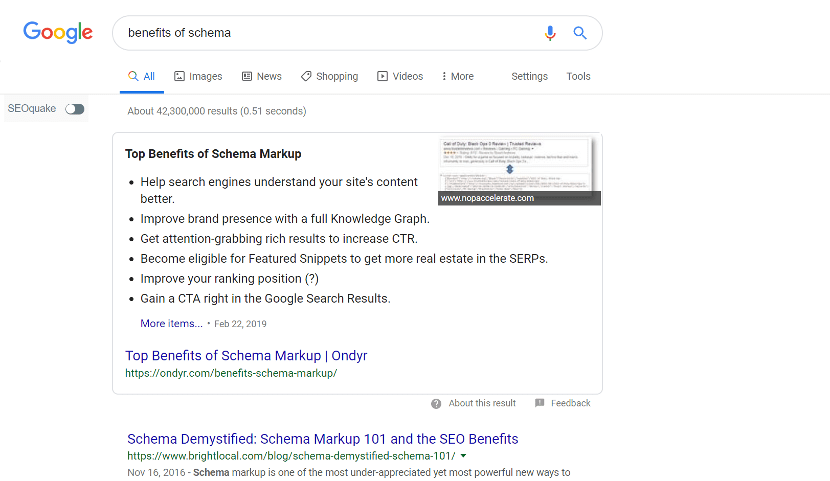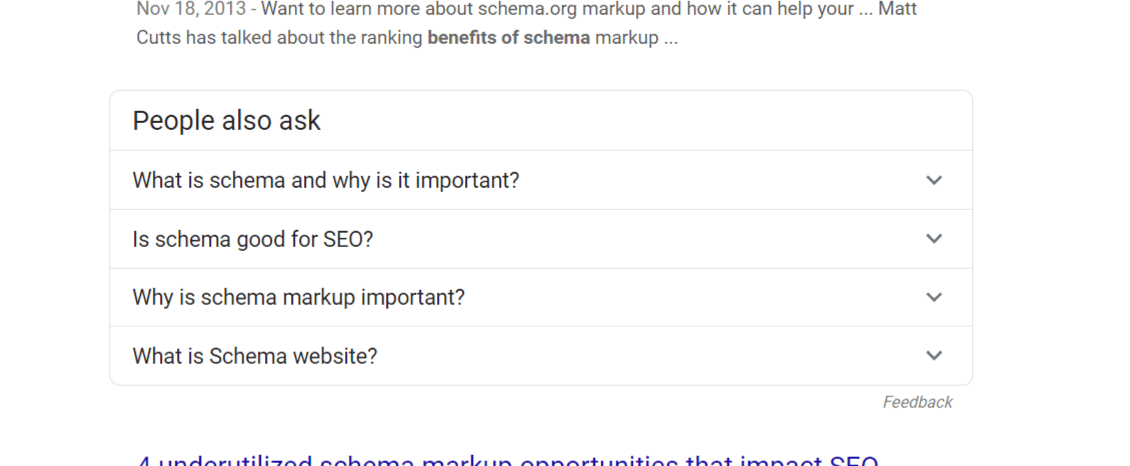Getting a Google featured snippet can improve your search presence, bring more traffic to your site, and position your site as an authority on a specific topic. So, how do you go about finding opportunities for featured snippets? And how do you optimize for winning featured snippets after you’ve done your research? We’ll take you through the process step-by-step.
by Sammi Dittloff and Stephen Stanczak | September 11, 2019
What is a Featured Snippet?

A featured snippet Ondyr recently won for its Top Benefits of Schema Markup article
Have you ever asked a question on Google that has a fairly straightforward answer, something that would take about a list or a paragraph to answer succinctly? If so, you might have made use of featured snippets on Google. Featured snippets show up at position 0 on Google’s search engine results page (SERP), meaning they show up above organic results on the page. It is an excerpt of a webpage that is designed to cover the query you searched. Google describes this feature as a way to help people “more easily discover what they’re seeking,” being even more useful via voice and mobile searching. You can click on the featured snippet to receive more information, but oftentimes, it is designed to answer the question without needing to click.
While featured snippets are not shown on every search, they are on the rise, with 23.9% of search results currently showing them. They usually appear in the form of paragraphs, lists, tables, or video clips. In some cases, they may be a mix of two types, like a paragraph and a list.
While featured snippets do not come from schema, both schema and featured snippets play a role in on-SERP SEO, what you see when reviewing results on Google. Other elements of on-SERP SEO include paid advertising, images, maps, Google My Business, knowledge cards or panels, videos, related questions, and more.
While some webpages may win featured snippets in very narrow subject areas, and only win with a search term or two, others become featured snippet hubs, winning position zero for multiple searches on just one page. Position zero refers to the fact that featured snippets are even above the #1 organic ranking. Health-related sites can be common featured snippet hubs because of their wide-ranging and specific knowledge, for example.
Why Are Featured Snippets Important?
You may be wondering why featured snippets are important to win, or why you should compete for something that may be reducing clicks to the regular search results. Google has come a long way, and it’s so much more than 10 blue links on a page. Google’s SERP has rich results, ads, maps, all kinds of on-SERP features you can interact with. Winning a featured snippet can get you at (or close to) the top of everything.
No-click searches have surpassed organic clicks for the first time, with over 50% of people not clicking on any organic result in the SERP. This is in part due to answers in featured snippets reducing clicks to organic results.
While earning a featured snippet may not always lead to traffic to your page, any featured snippet will also have a regular listing in the SERPS. So you are doubling your real estate in the SERP and the combined clicks of both results could be higher (as Hubspot found). Studies indicate that featured snippets still get 8.6% of all clicks on the page.
Plus, you would rather cannibalize your own organic clicks than having a competitor do so, right?
Whether you have evergreen content or it has to be regularly updated, featured snippets can serve as an important part of your overall web presence. Google has been favoring the freshest content for featured snippets, so you could see updating frequently, if you’re willing to do it, as your opportunity to win a spot. Volatility is possible with both evergreen and updated content, as Google works to better refine its algorithms and determine which answers are the most relevant based on the query.
Like we said above, featured snippets also play an important role in voice and mobile search. While voice search continues to evolve to more closely resemble human speech and thought patterns, it’s important to offer snippets that sound like complete human thoughts to our questions. Websites that are optimized for mobile (including AMP versions), have a better chance of winning featured snippets in mobile search.

Example of a People Also Ask box in search results
Another on-SERP place your content could land is in “People Also Ask.” This section is below the featured snippet and displays other, relevant answers to related search queries. If you’re looking to win a featured snippet for a keyword, but there’s a prominent website taking the top slot with a relevant answer, PAAs serve as an additional opportunity to make Google's first page. Plus, over 65% of SERPs have a “People Also Ask” box.
How Do You Track Whether You or Your Competitors Have Featured Snippets?
So, you now know what featured snippets are, and why they’re important in your content strategy, but how do you see which featured snippets you already have, and what your competitors have? You can use a few different SEO tools, including Ahrefs and SEMrush, to evaluate your coveted queries.
Ahrefs
In Ahrefs, you can use the Site Explorer to determine what featured snippets are owned by which domains. After entering the target domain, navigate to the organic keywords section and click on the SERP Features dropdown. Select Featured Snippets and “target domain must be featured.” This will show you what featured snippets the target domain you have chosen to search owns.
SEMrush
Finding featured snippet data with SEMrush is not quite as straightforward as Ahrefs. After setting up a project, you will find a Featured Snippets tab in the position tracking tool. This tab will show you, out of the keywords you’re tracking, which have featured snippets on SERP, and who owns those snippets (denoted by a crown). The tool also shares the traffic potential of winning different keywords. SEMrush Sensor, another feature of the tool, will tell you how often featured snippets show up in different industries, so you have a better idea of how likely you may be able to rank for featured snippets based on your given industry. For example, for food and beverage, featured snippets appear in 39% of search queries.
How Do You Get a Featured Snippet?
They say imitation is the sincerest form of flattery, and you can learn a lot from websites that have already won featured snippets about how to get some for yourself. Consider these factors when deciding on and refining content to contend for featured snippets.
Focus on Keywords Where You’re Already in Top 10
Sites essentially need to be at least in the top 10 (and preferably in the top 5) for a keyword to have a realistic chance at winning position zero. The volatility of featured snippet spots is still pretty high, so you have a shot when you’re in any position on the front page, but especially if you’re looking to prioritize optimizing existing content for featured snippets, first focus on keywords where you’re already ranking in the top 5.
Make Your Content Featured Snippet-Friendly
As we said, featured snippets are not driven by schema, but instead, are chosen based on your content and how it is formated. Follow these guidelines when writing featured snippet-friendly content:
- Use lists, tables, and concise paragraphs in your articles
- To increase the likelihood that people will click through to the webpage of a featured snippet, include a long list or table, which is less likely to be shown in full in the featured snippet so users have to visit the site for the full answer
- To win the featured snippet image, add text in the image itself - We see early indications that it could help win you the featured snippet as its likely Google is using OCR to find text in some images. You can win the paragraph but not the associated image and vice versa, so it's important to optimize both the paragraph and image for the best chance to win both.
- Include a bullet list summary at the top or bottom of the page
- Write your content like a featured snippet hub would. Tee up the content with words that signal an answer is coming. Be explicit about the question you’re answering.
- Consider trigger words like “are, can,” and “how” for paragraph answers, or list triggers like, “best, improve,” and “results.” Ideas for more triggers on these MozCon slides.
- Your content should follow the rules of journalism. Answer “Who, what, when, where, why” and “how” questions. For example, if the question is, “What are the most important points of this topic?” your content should say, “The most important points of this topic are…”
Spruce up your HTML, meta, and images
- List tags and table tags should be clearly structured in html
- Optimize images: Include alt text, keywords, and a descriptive title. Name your file descriptively rather than a generic file name. The header above your image should speak to what you’re trying to rank for. However, image URL isn’t ranked.
- Your content should have a clear header and subheader structure, especially H2 and H3 tags denoting different sections in your content
Leaving Feedback on Competitor Featured Snippets
Taking the steps above will ensure that you’ve followed best practices to earn featured snippets. Another strategy you can use is evaluating your competitors’ snippets and leaving feedback on any that have less-than-perfect answers.
Focus on competitor answers that could use improvement. Write a better answer than they have, and optimize your page in an attempt to overtake the snippet. Once you’ve made edits to your own content, re-index the page using Google Search Console. Then, leave feedback on the featured snippet (using the 'feedback' link found under the snippet), with details on how the answer could be better. (Note: Don’t abuse this button. It should be used when you see clear improvements that could be made to the answers.)
Where do you go from here?
You’ve identified your owned featured snippets and those of your competitors. You’ve found the highest potential keywords that you can try and rank for and have optimized accordingly. Plus, you’ve sent feedback to Google about competitor snippets that could be better. What comes next?
First, track your efforts. Whether that’s through a tool like SEMrush, Ahrefs, Google Search Console or a spreadsheet, track what you’re trying to rank for and monitor it over time. Take notes on the changes you’ve made, and identify patterns in any snippets you win. That can help you better revise content in the future to win more snippets. Google Search Console can also help you track click-through rates of rich results to get a sense of what kind of traffic featured snippets are generating for you.
Next, make a list of priorities for snippets that will be harder to win. You can use your current performance to decide where to expand. Consider what you want your site to be known for as well. Is your expertise coming out in your featured snippets? How could you write more content around that to increase the likeliness that it will?
Lastly, if for any reason, you want to opt-out of featured snippets on a page, you can add code to tell Google not to consider the page for that feature. That means you leave that field open for competitors, so opt out wisely.
Summary: How to Get a Featured Snippet on Google
- Use lists, tables, and concise paragraphs in your article
- To win the featured snippet image, add text in the image itself
- Include a bullet list summary at the top or bottom of page
- Use words that signal an answer and be explicit about the question you’re answering
- Consider trigger words like “are, can,” and “how” for paragraph answers, or list triggers like, “best, improve,” and “results.”
- Follow the rules of journalism: Answer “Who, what, when, where, why” and “how” questions.
- Use clean code for your HTML, meta tags, images, list tags, and table tags
- Optimize for images by including alt text, keywords, a descriptive titleand file name as well as a header above the image with target keyword
- Structure content with a clear header and subheader layout, especially H2 and H3 tags denoting different sections
If you would like any help in winning featured snippets or any other aspect of On-SERP SEO, feel free to contact Ondyr to explore projects.
More articles from Ondyr
Comments
People Also Ask: How to Use Google’s Related Questions to Their Fullest Potential
What is People Also Ask? People Also Ask, also known as related questions, is ...
Comments
What is On-SERP SEO and why is it important?
On-SERP (Search Engine Results Page) SEO is an umbrella term that encompasses every chance ...

